Since we were headed to British Columbia anyway to board our one-week cruise to the Alaska Panhandle, we felt it would be a good opportunity to stretch our vacation a bit longer, incorporating a visit with our friends, Paul & Sherry, in Victoria. All we needed was their willingness to put up with us. Fortunately, there was room at the Inn.
We left the Halifax airport early on the morning of August 22nd and found ourselves, a few hours later, with a 5-hour stopover in Toronto. To help break the boredom, internet access is most certainly available at Toronto Pearson……at a cost of $9.95 for a 24-hour period. Just exactly WHO has the yearning to spend 24 hours in the Toronto airport?
Arriving in the Vancouver airport, later that day, we found FREE internet access throughout the entire airport, just as it is at the Halifax Airport. This kind gesture was a sign of things to come. We were to find that the hospitality and consideration of the people on the west coast is every bit as good as it is here on the east coast.
Geography Lesson
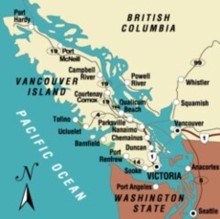 According to the brochure, "Vancouver Island is large, but sparsely populated. Rainforests, marshes, meadows, beaches, mountains, oceans, rivers and lakes create habitats for multitudes of wildlife species making it one of the world's most diverse ecosystems. The Island is divided, north to south, by the Beaufort Mountain Range. In addition to nature lovers, artists and artisans have flocked to this area over the years, drawn by its natural beauty."
According to the brochure, "Vancouver Island is large, but sparsely populated. Rainforests, marshes, meadows, beaches, mountains, oceans, rivers and lakes create habitats for multitudes of wildlife species making it one of the world's most diverse ecosystems. The Island is divided, north to south, by the Beaufort Mountain Range. In addition to nature lovers, artists and artisans have flocked to this area over the years, drawn by its natural beauty."
And speaking of natural beauty, our home for the first segment of our vacation was in Oak Bay, in the countryside overlooking the waters of the Strait of Georgia, but not all that far from downtown Victoria. Paul & Sherry live in a gorgeous house. Now I know how the Clampetts felt upon moving to a new home in Beverly Hills from their meagre abode near Bugtussle, Arkansas. We loved it!
Cherry Point Vineyards
The following morning a friend, Lorna, dropped by and kidnapped us for the day, not that Paul & Sherry had already grown sick of us (or did they?). You see, it was Sunday and this was the only day Lorna had available to be with us since, unlike most in my circle of friends, she had a Monday to Friday commitment called a “job”, whatever that is.
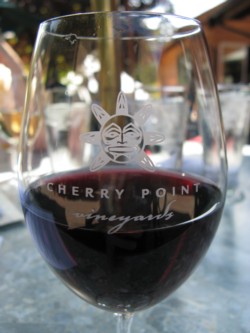 To our extreme delight and hilarity, Lorna gave us an extensive and scenic tour of numerous back-roads between Victoria and our scheduled first stop, Cherry Point Vineyards in Cobble Hill on Cowichan Bay, located on the east coast of Vancouver Island. This was more by accident than design as our accommodating tour guide kept making wrong turns along the way. But we did get to see a lot of gorgeous countryside that, otherwise, would have eluded us.
To our extreme delight and hilarity, Lorna gave us an extensive and scenic tour of numerous back-roads between Victoria and our scheduled first stop, Cherry Point Vineyards in Cobble Hill on Cowichan Bay, located on the east coast of Vancouver Island. This was more by accident than design as our accommodating tour guide kept making wrong turns along the way. But we did get to see a lot of gorgeous countryside that, otherwise, would have eluded us.
Arriving at the vineyards, in good humour, we all enjoyed a delicious meal accompanied by a glass of owner-produced Coastal Red, “A delicious blend with aromas of orange blossom, wild blackberry and spice. Juicy dark cherry fruit and black current flavor notes with a kiss of oak are followed by a peppery, berry finish. Food friendly wine, ideal while picnicking al fresco, barbequing or just sipping on the patio.”
The vineyard was established in 1990 when the founders purchased 34 acres on a former mink ranch. After the grape trials, Cherry Point Vineyards became one of the first licensed wineries on Vancouver Island in 1994. It is currently owned and operated by the Cowichan First Nation people.
Chemainus - The Little Town That Did
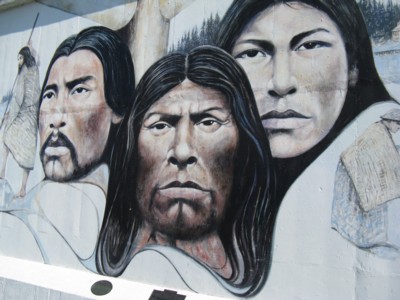 Chemainus has been labelled “The Little Town That Did.” Located a bit further up the coast from Cobble Hill, mining, fishing and forestry were the original industries that gave work to this area. However, those industries began to fail over the years and it was left up to the citizens of Chemainus to come up with an alternate means for providing employment. They devised a plan to create giant outdoor wall murals on the outside of building walls throughout their town. Through hard work, their plan met with success in great measure and Chemainus grew into a memorable tourist stop. As a result, their economy was revitalized.
Chemainus has been labelled “The Little Town That Did.” Located a bit further up the coast from Cobble Hill, mining, fishing and forestry were the original industries that gave work to this area. However, those industries began to fail over the years and it was left up to the citizens of Chemainus to come up with an alternate means for providing employment. They devised a plan to create giant outdoor wall murals on the outside of building walls throughout their town. Through hard work, their plan met with success in great measure and Chemainus grew into a memorable tourist stop. As a result, their economy was revitalized.
They started with 5 murals in the summer of 1981. By 1983, they had won the esteemed New York Downtown Revitalization Award for the redevelopment of the town core. Today they have grown to 41 murals plus carvings and statues depicting the history of their town. As a result, their economy is now been recharged.
Gail, Lorna and I spent the remainder of our afternoon admiring this superb artistry. But, as impressive as the murals are, so were the Gelatos that Lorna treated us to on the peaceful outdoor patio of the resident Gelateria.
Shaw Ocean Discovery Centre
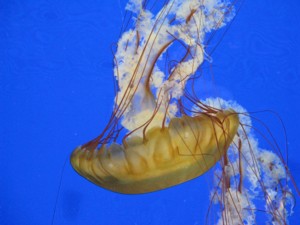 On Monday, we were back with our gracious hosts, Paul & Sherry, with so many things to do and so little time to do them. First up was a visit to the newly opened Shaw Ocean Discovery Centre in Sidney, again on the east coast of the island and not far from Chemainus.
On Monday, we were back with our gracious hosts, Paul & Sherry, with so many things to do and so little time to do them. First up was a visit to the newly opened Shaw Ocean Discovery Centre in Sidney, again on the east coast of the island and not far from Chemainus.
Shaw is a 10,000 square-foot aquarium and marine centre, created to provide local residents and visitors with an opportunity to learn more about marine life. The centre focuses on the amazing ecosystem of the Salish Sea, an area that includes the Strait of Georgia, Strait of Juan de Fuca and Puget Sound. Included are anenomes, sea stars, giant sea cucumbers, jellyfish, rock fish, salmon, wolf eels, crabs and lots more.
Yet another incredible Vancouver Island experience for us.
Butchart Gardens
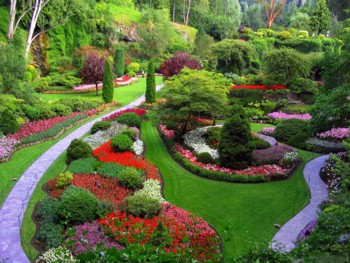 Robert Pim Butchart was an Owen Sound, Ontario, drygoods merchant. In 1888 he began to manufacture Portland cement. After much success in Ontario, he was attracted to Vancouver Island upon hearing of the rich limestone deposits, a vital component for cement production. In 1904, he and his family moved to Tod Inlet on Brentwood Bay, 23-km north of Victoria.
Robert Pim Butchart was an Owen Sound, Ontario, drygoods merchant. In 1888 he began to manufacture Portland cement. After much success in Ontario, he was attracted to Vancouver Island upon hearing of the rich limestone deposits, a vital component for cement production. In 1904, he and his family moved to Tod Inlet on Brentwood Bay, 23-km north of Victoria.
In time, a large gaping hole was left in the landscape near their house as the quarry had become exhausted. This sparked an idea in the mind of his wife, Jennie. She ordered up tons of topsoil from the surrounding farmland to line the bottom of the abandoned quarry and planted a gorgeous flower garden.
That was the origin of Butchart Gardens. Intrest grew as the garden expanded and by the 1920s over 50,000 people would come, annually, to enjoy the magnificence of the surrounding beauty.
Since then Buchart Gardens has remained in the hands of successive generations of the Butchart family and, although it has grown over the years, it has retained much of its original design and Victorian traditions. The gardens now cover more than 55 acres and attract in excess of one million visitors each year.
Either a day visit or a flood lit evening visit, Butchart Gardens must be seen to be truly appreciated. We had the best of both worlds having arrived in the daylight, and remaining onsite until after dark.
Being a Senior Citizen doesn’t mean you have to roll over and play dead
While in Victoria, I thought of a friend from my Run Canada days. Danny Daniels had been working in Whitehorse for many years and was the Yukon Delegate on the Run Canada Committee when I was the Nova Scotia delegate. After his workplace retirement, Danny and his wife Marge settled in Sidney, not far from Victoria.
I made a quick phone call. Danny and Marge said they’d be delighted to meet with us for a bit of a chin wag. He selected The Blithering Place, in Oak Bay, as our meeting spot the following morning.
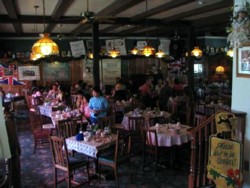 The Blithering Place is an authentic British Tea Room straight out of the Thirties and Forties. Their brochure reads, “Here, you may enjoy tea in the traditional manner. You will find locals enjoying moments of "blethering" in a setting of lace curtains and flowers. Billy Bunter, The Beano and Biggles, Enid Blyton, Golliwogs and Churchill welcome you,...all nestled in the heart of a charming English village, just seven minutes from Victoria's inner harbour.”
The Blithering Place is an authentic British Tea Room straight out of the Thirties and Forties. Their brochure reads, “Here, you may enjoy tea in the traditional manner. You will find locals enjoying moments of "blethering" in a setting of lace curtains and flowers. Billy Bunter, The Beano and Biggles, Enid Blyton, Golliwogs and Churchill welcome you,...all nestled in the heart of a charming English village, just seven minutes from Victoria's inner harbour.”
Sure was good to be reacquainted after so many years had passed. Danny and I started, immediately to chat about “old times” while Gail, Sherry and Paul had a delightful conversation with Marge.
It certainly wasn’t “blither” when Danny, with a proud elongated smile, plunked a shiny new medallion down on the table in front of me. He had recently returned from Lahti, Finland where he had competed in the 2009 World Masters Athletic Championships, claiming third place in his age class in the Decathlon. With an accumulation of 4640 points, he established a new Canadian Age Class Record.
He’s 80 years old!
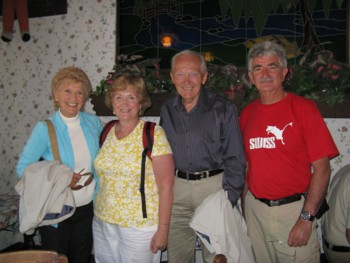
He and Marge couldn’t stay long as they were off to an appointment. Not sure if it was choir practice where he has been a featured soloist many times; step dancing classes that both he and Marge regularly attend or if he was gallivanting off somewhere on the other side of Canada to attend a meeting in his position of Vice Chair on the Board of Directors of Athletics Canada.
Sure takes the wind out of one’s sails when we start whining about being too old to do this or that.
Craigdarroch Castle
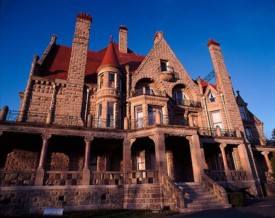 Robert Dunsmuir was born in Kilmarnock, Scotland in 1825. He moved to Canada to take up a position with the Hudson’s Bay Company on the west coast in 1850. In 1855 he was granted the right to prospect for and mine coal. In 1869 he found Vancouver Island’s richest coal seam ever, near Nanimo. His business empire grew to include a railway; a shipping line; iron works; a saw mill; a quarry; a dyking company; a theatre and extensive real estate.
Robert Dunsmuir was born in Kilmarnock, Scotland in 1825. He moved to Canada to take up a position with the Hudson’s Bay Company on the west coast in 1850. In 1855 he was granted the right to prospect for and mine coal. In 1869 he found Vancouver Island’s richest coal seam ever, near Nanimo. His business empire grew to include a railway; a shipping line; iron works; a saw mill; a quarry; a dyking company; a theatre and extensive real estate.
In 1887 he gave orders to begin the construction of Craigdarroch Castle in Victoria, which was to become home to he and his family. But that’s where his good fortune ended. He died in 1889 before the castle was completed. As they say, money can’t buy everything.
His family did move in a year after his death, but ineptness and continuing squabbles among the family members during the coming years sent the Dunsmuir estate down the tubes. The castle ended up becoming a military hospital (1919-1921); a wing of Victoria College (1921-1946); Victoria School Board Office (1946-1968) and the Victoria Conservatory of Music (1969-1979). Since 1979, the castle has been owned by a non-profit group, Craigdarroch Castle Historical Museum Society, and receives 150,000 visitors annually after being refurbished back to the grandeur of its castle status.
This is another gem we visited with Paul and Sherry while in Victoria. The woodwork and stained glass windows are stunning masterpieces.
Emily Carr House
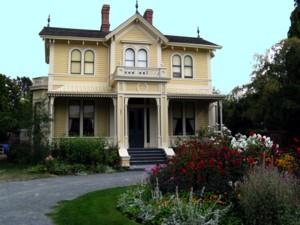
Earlier in the year, when we had decided to visit Victoria, I began to research things to do and see while there. After signing several books out at the library, the paintings and writings of Emily Carr (1871 – 1945) came to the forefront. I had previously known very little about her but soon came to learn that she was an interesting, if a rather eccentric, lady – kind of like a female version of my buddy Gordie Warnica. I was bitten and had to know more about Emily Carr.
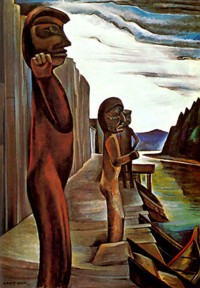 While in Victoria, we visited her place of birth and first home, which is now a museum, the Emily Carr House. I had learned about Emily, and the house, from the reading I had done and certainly was not disappointed with our visit. Parked in the front yard was “The Elephant”, the caravan Emily had used during her many painting excursions to the forests and coasts of Vancouver Island. Although there are none of her original paintings in the house, it has been furnished to resemble what it would have looked like at the time she lived there. To be in her house and to be standing in the rooms where she once stood was, for me, an exhilarating experience.
While in Victoria, we visited her place of birth and first home, which is now a museum, the Emily Carr House. I had learned about Emily, and the house, from the reading I had done and certainly was not disappointed with our visit. Parked in the front yard was “The Elephant”, the caravan Emily had used during her many painting excursions to the forests and coasts of Vancouver Island. Although there are none of her original paintings in the house, it has been furnished to resemble what it would have looked like at the time she lived there. To be in her house and to be standing in the rooms where she once stood was, for me, an exhilarating experience.
Later in the week, Paul and I visited the Art Gallery of Greater Victoria where a large selection of her paintings is kept in a permanent collection. I could have stayed for hours and hours.
Fisherman's Wharf
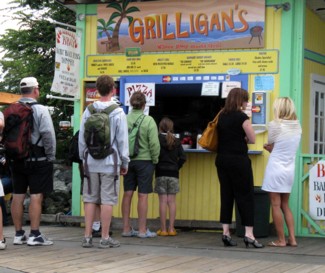 We visited Fisherman’s Wharf on Victoria’s Inner Harbour. This is a charming collection of wharfs; picturesque houseboats; harbour ferries; vendors selling the catch-of-the-day, fresh from the ocean; ice cream outlets, and in our case Pamela Anderson ordering up a plate of fish & chips from Grilligan’s. A native of Ladysmith, further up the island, Pam was in the area for a visit and dropped by for lunch with us (sort of).
We visited Fisherman’s Wharf on Victoria’s Inner Harbour. This is a charming collection of wharfs; picturesque houseboats; harbour ferries; vendors selling the catch-of-the-day, fresh from the ocean; ice cream outlets, and in our case Pamela Anderson ordering up a plate of fish & chips from Grilligan’s. A native of Ladysmith, further up the island, Pam was in the area for a visit and dropped by for lunch with us (sort of).
That evening, we went to a British-style pub where I devoured a scrumptious plate of Bangers and Mash, accompanied by a locally crafted ale. The perfect ending to yet another good day on the west coast.
Cathedral Grove
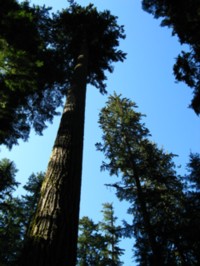 Well-know forester, H.R. MacMillan, donated 136 hectares of land in 1944 to be set aside as a parkland to preserve a piece of Vancouver Island for perpetual public enjoyment. Today, Cathedral Grove in MacMillan Provincial Park, proudly displays a unique stand of Douglas fir, Western Hemlock, Grand fir and Western Red Cedar.
Well-know forester, H.R. MacMillan, donated 136 hectares of land in 1944 to be set aside as a parkland to preserve a piece of Vancouver Island for perpetual public enjoyment. Today, Cathedral Grove in MacMillan Provincial Park, proudly displays a unique stand of Douglas fir, Western Hemlock, Grand fir and Western Red Cedar.
The, now expanded, 157-hectare park is located on both sides of the Tofino Highway on the shores of Cameron Lake. 10 miles east of Port Alberni. Numerous trails provide circuits between towering trees, some more than 800 years old and one measuring more than 9 metres in circumference.
Amazing!
Duncan - City of Totems
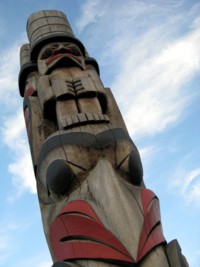
Originally a whistle stop on the E&N Railway, near Chemainus, the City began to expand when a train station was built in 1887 attracting new business and settlement to the area.
The “City of Totems” celebrates the history and culture of the area’s First Nation People who have made a name for themselves worldwide with their native carvings and knit “Cowichan Sweaters”. There are now over 80 totem poles erected throughout the city.
Not to be outdone by the totems, Duncan also claims ownership of the world’s largest hockey stick and puck, a fact properly recorded in the Guinness Book of World Records.
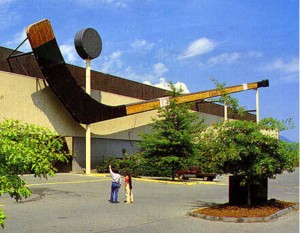 The stick and puck are proudly affixed to the side of the Cowichan Community Centre. The 205-foot hockey stick, made from Douglas Fir wooden beams reinforced with steel, weighs 61,000 pounds. It was originally commissioned by the Government of Canada as part of the Expo '86 World's Fair Exposition in Vancouver. At the close of the fair, the people of Duncan successfully won the bid to have it moved to their community.
The stick and puck are proudly affixed to the side of the Cowichan Community Centre. The 205-foot hockey stick, made from Douglas Fir wooden beams reinforced with steel, weighs 61,000 pounds. It was originally commissioned by the Government of Canada as part of the Expo '86 World's Fair Exposition in Vancouver. At the close of the fair, the people of Duncan successfully won the bid to have it moved to their community.
Although it’s never been tested, it’s sure to cause many an avid hockey fan from coast to coast to coast to salivate, speculating what kind of a gash that particular stick could open up in an opponent’s forehead or how many teeth it could cause to be dislodged if properly swung. :=)
Finding a “Puddle Bird” at Esquimalt Lagoon
Not just a "birder", Gail is now officially a “twitcher” having travelled over 4,000-km to successfully observe birds in the wild. You know the type – a pair of obligatory Bausch & Lomb 8 X 36s dangling from their neck and the likelihood of club endorsed eccentric headwear affixed to their domes. And don’t be alarmed if they walk with a bit of a strange swagger when you encounter them in the wild - chances are they’ve just “ticked” a “puddle bird” as a “lifer” on the appropriate page in their copy of Petersons Field Guide to the Birds. The strange walk comes about because they’ve just peed themselves from the resulting excitement of seeing a rare bird. Thus the name “puddle bird”.
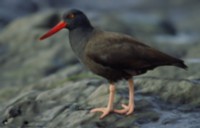 We spent a productive morning at Esquimalt Lagoon. Lots of Canada Geese and two types of Swans (one with an orange bill and one with a black bill....perhaps Orange Billed and Black Billed Swans? No?). Then there was a crow, but not a Nova Scotia-type crow and another black bird, which was probably a Blackbird. Thankfully, though, there were no “LBJs” (you know, Little Brown Jobbies).
We spent a productive morning at Esquimalt Lagoon. Lots of Canada Geese and two types of Swans (one with an orange bill and one with a black bill....perhaps Orange Billed and Black Billed Swans? No?). Then there was a crow, but not a Nova Scotia-type crow and another black bird, which was probably a Blackbird. Thankfully, though, there were no “LBJs” (you know, Little Brown Jobbies).
But the piece de resistance was our sighting of a definite puddle bird, the elusive Black Oyster Catcher. How’s that for excitement?
Alaskan Cruise
Next up was our Alaskan Cruise. Paul and Sherry kindly drove us directly from Victoria to Vancouver and straight onto the cruise ship's docking pier at Canada Place. I guess they wanted to make sure were were gone. As the saying goes, "After 3 days both fish and company start to smell". We had stayed with them for a week. :=)
For details on the Alaska trip, click here: North to Alaska.
Back in Vancouver - Gastown
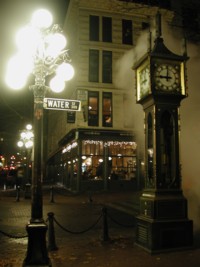
Back in Vancouver, fresh from our trip to Alaska, we had 2 ˝ days to roam around the city before heading home. On our first day, we took in Gastown, named after enterpreneur "Gassy Jack” Deighton. He arrived on site in 1867, the same year Canada became a Federation, with a barrel of whiskey and set up a saloon to the joy of the local mill workers - a neighbourhood was born. His nickname was the result of his propensity for talking incessantly while delivering the odd unbelievably believable tall tale.
Gastown grew to be incorporated as part of Vancouver in 1886 and continued to prosper until the depression years when it fell on hard times. It wasn’t until the 1960s that it was rejuvenated, resulting in it being named an historic site in 1971, thus protecting its historic buildings.
Today, Gastown is a popular attraction for tourists as well as city residents with its wide variety of restaurants, night clubs and trendy shops. One of its most identifiable features is the steam clock which was built in 1977. The clock operates through the use of a steam engine and electric motors displaying the time on all four faces. Every quarter hour a set of steam-driven whistle chimes play the Westminster Quarters.
More of Emily Carr
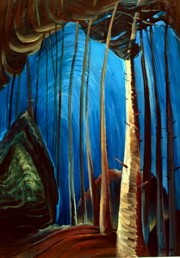
Next was the Vancouver Art Gallery with its display of Emily Carr sketches and paintings as well as exhibits from the works of several other famous international artists. But I was there to view Emily Carr’s paintings - at least I can spell and pronounce her name. Yet again, I felt privileged to be in the presence of her artwork.
Emily Carr’s main claim to fame is her paintings of Canada’s West Coast natives and nature. She was one of the first artists to concentrate on the spirit of Canada rather than on portraits and landscapes. However, she is also to be remembered for her writing – Klee Wyck, The Book of Small, The House of All Sorts, Growing Pains, Pause, The Heart of the Peacock and Hundreds and Thousands. She also made pottery and hooked rugs that incorporated First Nations designs.
As with a lot of artists, Emily Carr sold only a small portion of her works during her lifetime. To support herself she took in boarders in her House of All Sorts, she grew and sold vegetables and fruit, raised chickens and rabbits for sale, and bred and sold more than 350 bobtail puppies. Most of her painting was done in oil on canvas but, during tough times, she would be forced to cheaper means, often mixing gasoline with the oil paint to make it go further and painting on manila paper rather than on canvas.
The Hop-On Hop-Off Trolly
 On day #2 we discovered the nifty Hop-On Hop-Off Trolly that does two separate circular tours and includes most of the major attractions in Vancouver. Narration on the turn-of-the-century trollys is provided during the ride by informative and cordial drivers who make extra stops to accomodate various passenger and even went off route to drop us off at our hotel when it started to rain.
On day #2 we discovered the nifty Hop-On Hop-Off Trolly that does two separate circular tours and includes most of the major attractions in Vancouver. Narration on the turn-of-the-century trollys is provided during the ride by informative and cordial drivers who make extra stops to accomodate various passenger and even went off route to drop us off at our hotel when it started to rain.
As the name implies, one is able to “hop off” the trolly at a location of interest, then “hop on” the next trolly which will be along within 15 minutes.
Granville Island
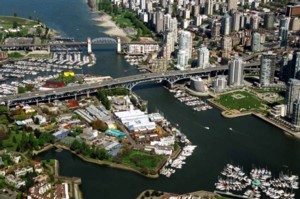 We “hopped off” at Granville Island and spent a pleasurable time exploring the various buildings and vendors. "It is physically connected to the city by a causeway from the south that provides no hint of the treasures that await visitors. Its humble origins are philosophically far removed from what it has become, a sophisticated home to performing arts, art education, dining, artists' studios and workshops, art galleries and a fabulous public market that offers the widest array of fresh food in the Lower Mainland as well as a favourite place for people to meet, eat and spend some time in a safe and relaxing environment." (I could not have said it better myself)
We “hopped off” at Granville Island and spent a pleasurable time exploring the various buildings and vendors. "It is physically connected to the city by a causeway from the south that provides no hint of the treasures that await visitors. Its humble origins are philosophically far removed from what it has become, a sophisticated home to performing arts, art education, dining, artists' studios and workshops, art galleries and a fabulous public market that offers the widest array of fresh food in the Lower Mainland as well as a favourite place for people to meet, eat and spend some time in a safe and relaxing environment." (I could not have said it better myself)
As we were eating our lunch, we were joined by a friendly Calgary couple – she is originally from Germany; he from Scotland. He, being an engineer who works with water purification systems, was most interested in the status of our ongoing waterfront sewage woes here in Halifax. He made mention of that famous scene last year that, apparently, was viewed all across Canada and beyond, when Mayor Kelly publicly soaked himself in the Black Rock Sewer in a (failed) attempt to show how clean the water actually is. “I read the stats on that water. Doesn’t that boy have even a basic knowledge of chemistry?” my new Scottish friend asked with a knowing smile.
Classical Chinese Gardens
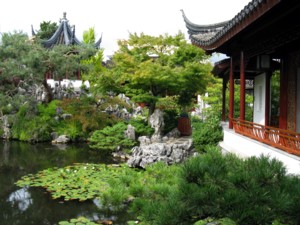 Incorporated in 1981, The Dr. Sun Yat-Sen Garden Society is a self-sustaining, not-for-profit organization with the mandate, “To maintain and enhance the bridge of understanding between Chinese and Western cultures, promote Chinese culture generally and be an integral part of the local community”.
Incorporated in 1981, The Dr. Sun Yat-Sen Garden Society is a self-sustaining, not-for-profit organization with the mandate, “To maintain and enhance the bridge of understanding between Chinese and Western cultures, promote Chinese culture generally and be an integral part of the local community”.
Using 52 master craftsmen from Suzhou, China, the Ming dynasty garden opened in 1986 after a year of construction. Everything was constructed with precise joinery, without the use of nails, screws or glue.
“Like every classical Chinese garden, the design of the Dr. Sun Yat-Sen Garden is based on the harmony of four main elements: rock, water, plants, and architecture. Together, these four elements combine to create a breathtaking experience of perfect balance, yin and yang.”
We spent a few peaceful and relaxing hours on this gorgeous piece of earth that somehow causes you to forget you are in the middle of a bustling city and that there are nasty things going on in other parts of our world. This place is a must for anyone travelling to Vancouver.
Stanley Park & the Vancouver Acquarium
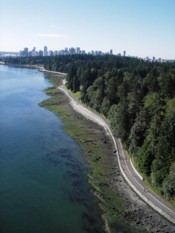 Vancouver’s first City Council petitioned the Federal Government, in 1886, to lease 1,000 acres of land to be used as a park and recreation facility. Their petition being successful, Stanley Park opened on September 27, 1887, named after Lord Stanley, Govenor General of Canada. Now the third largest urban core park in North America, the park attracts up to eight million visitors each year.
Vancouver’s first City Council petitioned the Federal Government, in 1886, to lease 1,000 acres of land to be used as a park and recreation facility. Their petition being successful, Stanley Park opened on September 27, 1887, named after Lord Stanley, Govenor General of Canada. Now the third largest urban core park in North America, the park attracts up to eight million visitors each year.
We used our Hop-On, Hop-Off bus passes to take a tour of the park, stopping for a walk through the Rose Garden which was established by the Kiwanis Club in 1920. 35,000 plants are now on display in the garden.
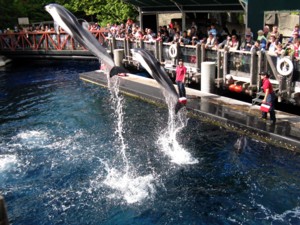
A short walk beyond the Rose Garden took us to the Vancouver Aquarium, home to over 70,000 creatures, but I counted only 69,999 – not sure if the other one was hiding from me or trapped inside someone else's stomach.
A great way to spend a day. The dolphins, sea otters and beluga whales were the stars of the show, in my estimation.
Our visit to the 4D theatre was "interesting". Don't go there if you mind having wind and water sprayed in your face as dolphins leap over the waves on the 3D screen and various objects poke you in the back or wrap around your legs as sea snakes go swimming by.
After the aquarium, and a delicious meal at Stanley Park's Fish House, we felt vacationed out and were on our way to the airport to get back home for a much needed rest. (Is that the way it’s supposed to work?)
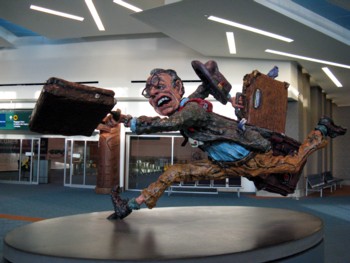
All in all, it was a great vacation and a renewed appreciation for Canada's west coast. Many thanks to Paul & Sherry, Lorna and the 794 crew members on the Zeiderdam cruise ship for their part in creating such a memorable event for us. A very special thank-you to my buddy, Mark Bernard, for being at the Halifax airport to greet us and to drive us home at the end of our journey, and to our family members (Adrian, Jon & Terra) for taking care of our house and our much loved pets while we were away.
Jerome Bruhm
WARNING!!!! VACATION PHOTOS!!!!
If you want to see a collection of our trip photos, including several of the better ones that were taken by others, click on Picasa Photo Album at the top of this article. 9 1/2 minutes to see all of them - enter at your own risk!
Oh, and if you think I wrote all of the above without the help of brochures, I know of a good piece of swampland on Esquimalt Lagoon that you may want to purchase for a building lot.
|